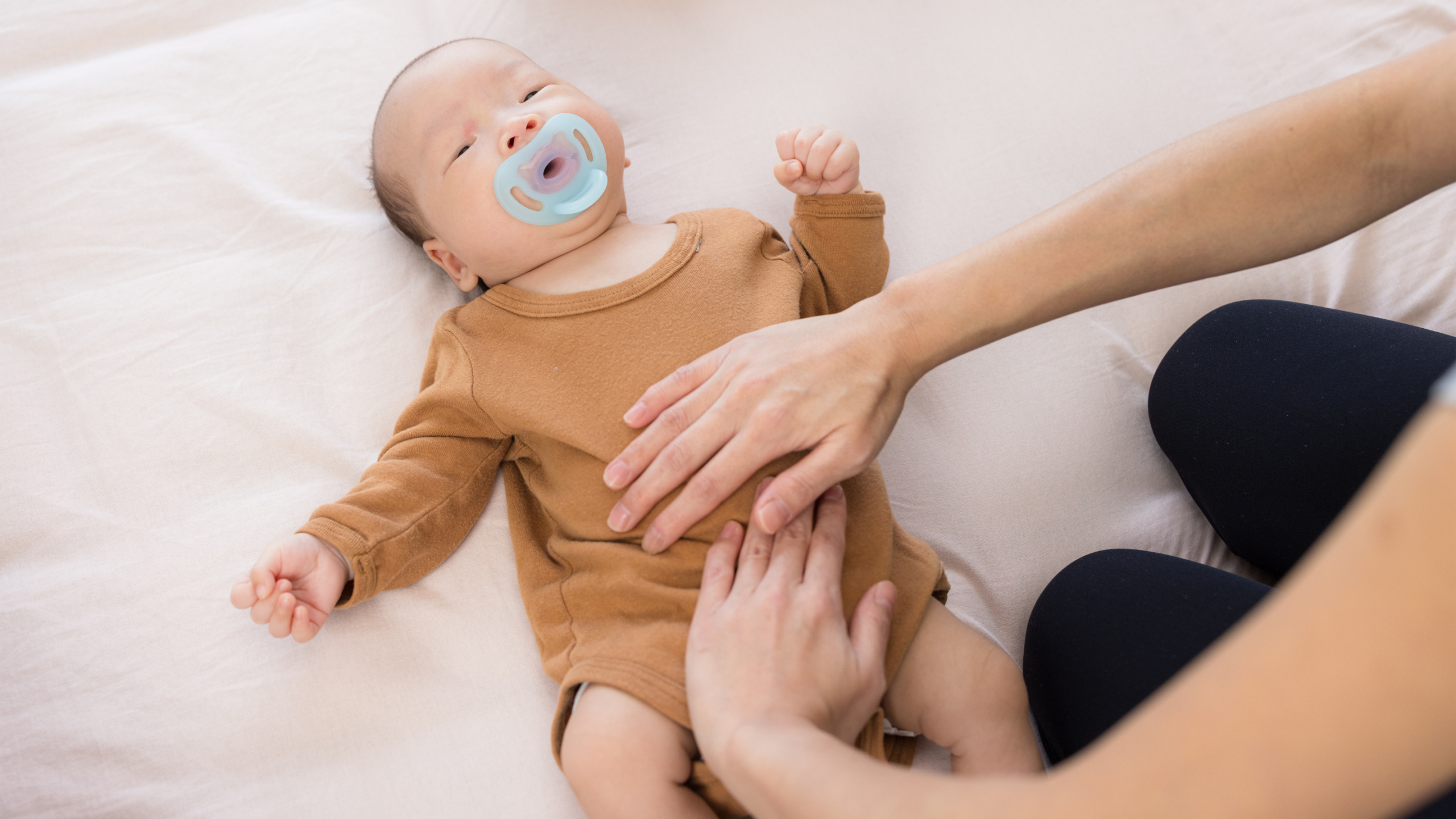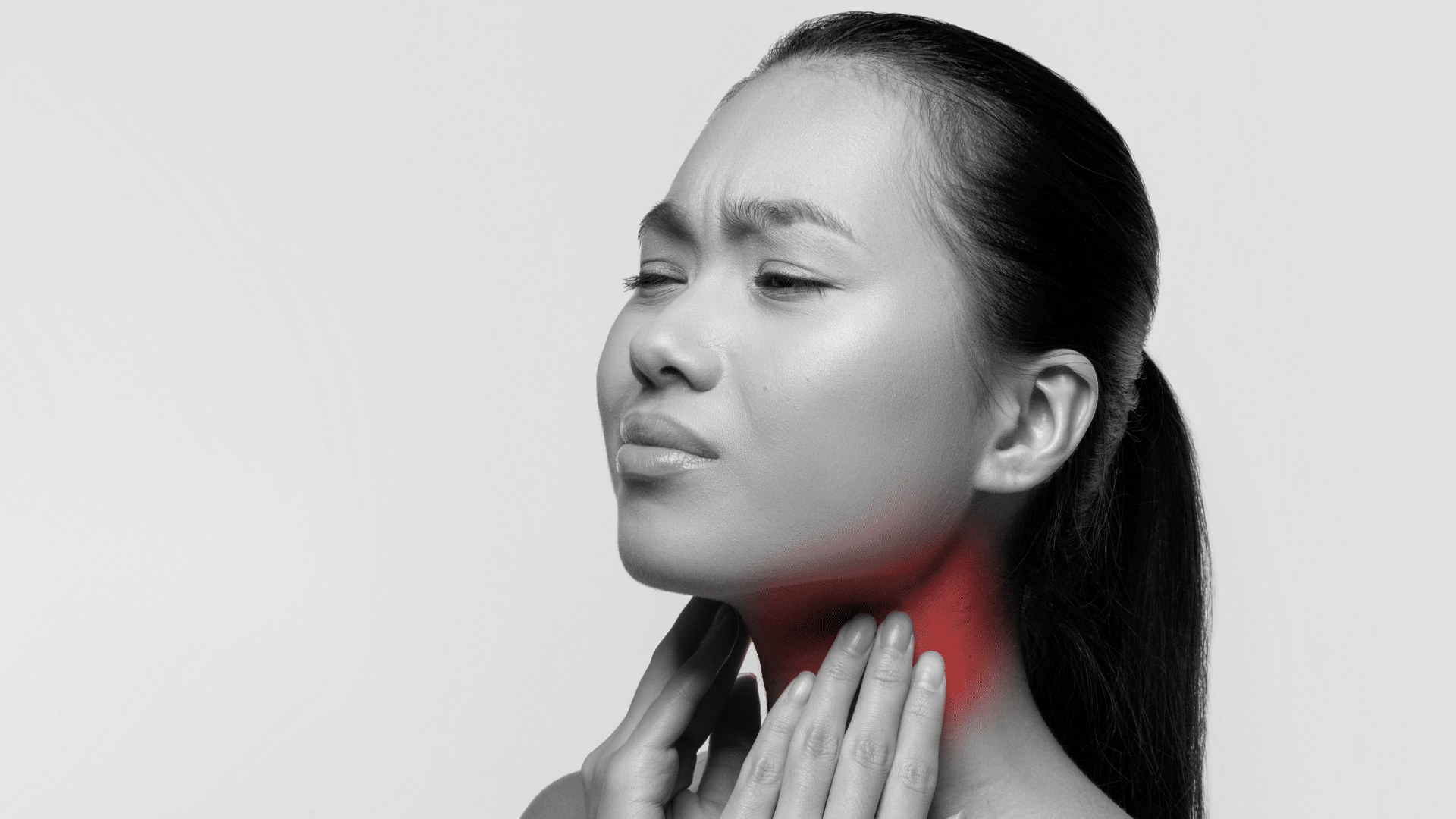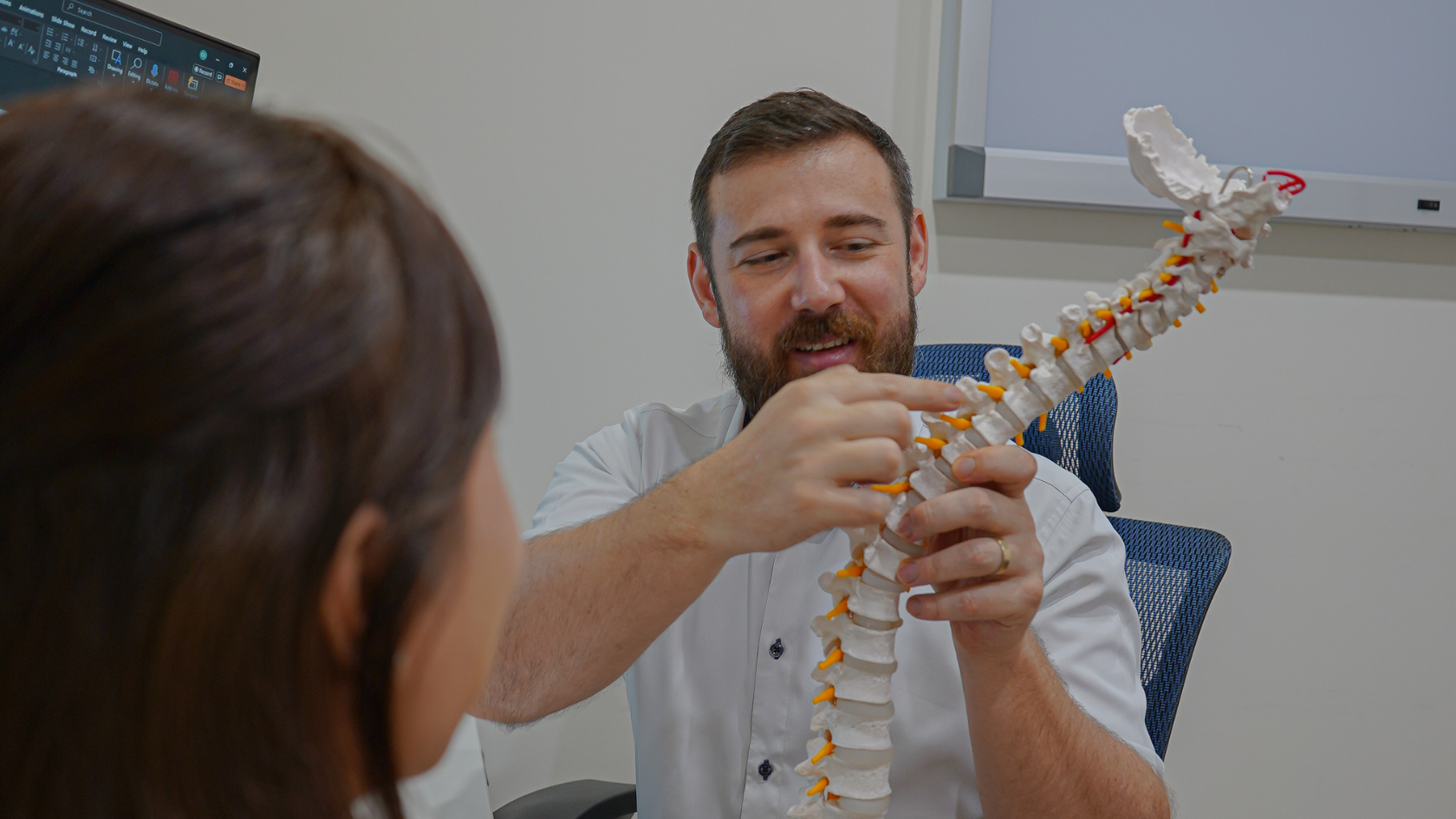Welcoming a newborn is both magical and overwhelming. For many parents, carrying their baby feels instinctive — but it’s important to remember that a newborn’s body is delicate and still developing. Knowing how to carry a baby properly is not only about comfort; it’s also about supporting healthy growth, ensuring safety, and protecting your own spine and joints from unnecessary strain.
Why learning how to carry a baby matters for new parents
A newborn’s spine is naturally rounded and still developing, which makes proper carrying essential in the early months. The wrong position can strain fragile muscles and joints or even restrict airflow if the head is not well supported. Correct carrying, on the other hand, supports healthy growth and encourages bonding through skin-to-skin contact and gentle eye-level interaction.
For new parents, carrying a baby can feel instinctive yet daunting. The hours spent holding, feeding, and soothing often take a toll on your own body, leading to backaches, shoulder stiffness, or wrist strain if posture is poor. Simple habits such as switching sides and using a supportive baby carrier can make carrying safer and more comfortable for both parent and child.
With the right knowledge, you can develop safe, comfortable habits from the start. These routines not only protect your baby’s spine but also shape the way you bond and grow together in the months ahead.

This guide will cover everything you need to know about how to properly carry a baby, from the first trip home from hospital to using a baby carrier, sling, or wrap. We’ll also explore how carrying changes as your child grows, explain how to burp a newborn, and clarify whether a newborn needs a pillow. Alongside this, you’ll find practical advice for parents to maintain healthy posture and avoid strain.
Advice for new parents: How to provide neck & head support when carrying a newborn baby
In the first three months, your newborn has little to no neck control. That’s why whenever you lift, soothe, or carry them, one hand must always support the head and neck while the other secures the back and bottom. This simple habit protects your baby’s developing spine and keeps them safe in your arms.

Here are three of the most common and practical holds every new parent should know:
- Cradle hold: Perfect for feeding and bonding. Place your baby’s head in the crook of your elbow, with your forearm supporting the spine and your hand under the bottom. This position allows for eye contact and closeness.
- Shoulder hold: Comforting for burping and soothing. Rest your baby upright against your shoulder, supporting the head with one hand while the other holds the back. Many parents love this because it lets the baby hear their heartbeat.
- Belly hold: Helpful for babies with gas or colic. Lay your baby tummy-down across your forearm, with the head supported in your palm or elbow. The gentle pressure on the tummy can provide relief.
No matter which position you choose, always ensure your baby’s face is visible, their airway is clear, and their chin is not pressed down onto their chest. These simple checks give you peace of mind while making carrying both safe and comfortable.
How to carry a baby at different stages of growth
Babies grow and develop rapidly in their first year, and the way you carry them should adapt to their changing needs. Knowing how to carry a baby at each stage ensures proper support for their spine, head, and hips — while also making things easier for parents.
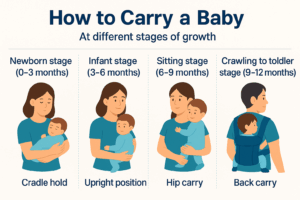
How to carry a Newborn (0–3 months)
- Key need: Full head and neck support, gentle handling.
- Best holds:
- Cradle hold for feeding and bonding.
- Shoulder hold for burping.
- Belly hold for colic relief.
- Avoid: Sitting your newborn upright unsupported, as their spine is not yet ready.
How to carry a 3–6 months old baby
- Key need: Partial head control, beginning of trunk strength.
- Best holds:
- Upright positions, as babies can now start looking around.
- Supported sitting on your lap with hands stabilising the trunk.
- Baby carriers or wraps with newborn inserts.
- Tip: Start practising short periods in a baby carrier facing inward.
How to carry a 6–9 months old baby
- Key need: Strengthening spine, developing balance.
- Best holds:
- Hip carry — resting on your hip with one arm supporting.
- Baby carrier without newborn inserts if the baby has full head control.
- Sling in a seated position with legs in an “M” shape.
- Note: Babies at this stage enjoy facing outwards in carriers for short periods, but inward-facing is still safest for long durations.
How to carry a toddler (9–12 months and beyond)
- Key need: Mobility, curiosity, and weight distribution for parents.
- Best holds:
- Hip carry becomes natural and convenient.
- Back carry in a baby carrier — distributing weight evenly for parents during longer walks.
- Piggyback style (with proper carriers) can also be introduced.
- Tip: Toddlers are active and may lunge unexpectedly, so always keep a secure grip.
How to carry a baby back from hospital?

The first journey home is unforgettable but can also feel nerve-racking. You’ll want to make sure your baby is safe and secure:
- Use a car seat: In Singapore, an approved infant car seat is required by law. Make sure it is rear-facing, properly installed, and correctly fastened.
- Carrying in arms: If walking a short distance (for example, from ward to car), use the cradle or shoulder hold. Move slowly and carefully, supporting the head and neck at all times.
- Prepare before discharge: Adjust car seats and practise fastening them before the day of discharge. This reduces stress and ensures you can focus fully on your newborn.
Why consider a baby carrier for better support?
Using a baby carrier can be a game-changer for parents. A well-designed carrier does more than free up your hands — it also distributes your baby’s weight evenly across your shoulders, back, and hips. This prevents strain from building up in one area and makes it easier to carry your baby for longer periods.
Look for ergonomic carriers that:
- Support your baby’s hips in the natural “M” position.
- Offer padded shoulder straps and waistbands for your comfort.
- Allow you to adjust fit as your baby grows.
By combining mindful posture with the right tools, you’ll protect your own body while keeping your baby close and supported.
How to carry a baby in a baby carrier?
A baby carrier is practical for outings, walks, or even doing light household chores. However, safety depends on fit and age-appropriateness:
- For newborns: Choose carriers designed for infants or use a newborn insert. Ensure the head and neck are supported.
- For hip health: Look for carriers that support the “M” position — knees higher than bottom, thighs supported, legs spread comfortably. This supports healthy hip development.
- Positioning: Babies should face inward until they have good neck and trunk strength (around 4–6 months).
- Time limits: Avoid keeping your baby in a carrier for excessively long periods. Take breaks to stretch, feed, and check for overheating.
How to carry a baby in a sling or wrap?
Slings and wraps can provide closeness and convenience, but they must be used correctly to ensure your baby’s safety and comfort. Learn more about the different types of baby carriers, which are most suitable, and how to use them here.
How to Carry a Baby with Colic
What is Colic?
Colic refers to frequent, prolonged crying or fussiness in an otherwise healthy baby, usually starting within the first few weeks of life. These episodes can be intense, often peaking in the evening, and may last for several hours at a time.

This is how you properly carry a baby with colic: the way you hold your baby can make a big difference in easing their discomfort. Certain positions relieve abdominal pressure, help with trapped wind, and offer soothing comfort:
- Belly Hold to address colicLay your baby tummy-down across your forearm, with their head turned to one side and legs straddling your arm. Gentle pressure on the abdomen can reduce gas build-up and soothe crying spells.
- Upright Hold to address colicPosition your baby against your chest or shoulder after feeds. Supporting the head and back while keeping them upright helps air bubbles escape more easily during burping.
- Gentle Rocking to address colicSlow, rhythmic movement — whether in your arms, on your shoulder, or in a rocking chair — can provide a calming, womb-like sensation for your baby.
Why Knowing How to Burp a Newborn Matters
During feeding, babies often swallow air, which can cause fussiness, discomfort, or even colic. Learning how to burp a newborn is just as important as knowing how to carry them safely. Here are three gentle and effective methods:
- Over the shoulder to burp babyHold your baby upright against your chest, supporting their head and neck with one hand. Gently pat or rub their back until they release trapped wind.
- Sitting on your lap to burp babyPlace your baby in an upright sitting position on your lap. Support the chest and head with one hand while leaning them slightly forward, and use your other hand to pat their back.
- Across your lap to burp babyLay your baby tummy-down across your legs, keeping their head slightly higher than their chest. Gently pat or rub their back to help bring up the wind.
Always keep a muslin or cloth handy, as posseting (spitting up a little milk) is common during burping.
Caring for yourself while carrying a baby
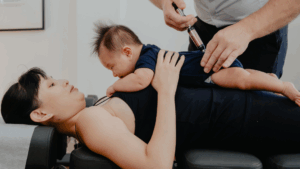
How does posture affect parents when carrying a baby?
Parents often spend hours a day carrying, feeding, or rocking their baby. Without awareness, this can quickly take a toll. Common posture mistakes include:
- Resting the baby on one hip for too long.
- Leaning forward while feeding or burping.
- Using only arm strength instead of engaging the core.
Over time, these habits can lead to back pain, shoulder tightness, or even wrist strain (sometimes called “mummy’s thumb”).
Seeking professional guidance on how to carry a baby properly
Carrying a baby without proper support may place strain on their delicate spine and muscles, leading to postural or developmental issues that can have long-term effects. For parents, poor carrying techniques can also cause back pain and fatigue, making it harder to keep up with the needs of a growing child. Seeking professional guidance ensures both baby and parent are better supported.

Can chiropractic care help parents with posture and comfort?
Parents often overlook their own wellbeing while caring for their newborn. Chiropractors are trained to assess posture and spinal alignment, offering guidance on everyday ergonomics. For parents dealing with stiffness or backaches from frequent lifting, chiropractic care can provide strategies to move, carry, and sit in ways that reduce strain.
How can chiropractors guide safe carrying positions?
At Chiropractic Singapore, our chiropractors are trained to observe the way parents carry, feed, and soothe their babies. With gentle guidance, they can:
- Assess your posture while carrying and suggest simple adjustments for better comfort.
- Share ergonomic techniques for everyday routines such as feeding, burping, and lifting.
- Provide lifestyle and posture tips that help reduce strain on your back, shoulders, and joints.
By supporting parents in these practical ways, chiropractic guidance helps create a safer and more comfortable experience — ensuring both you and your baby feel cared for in daily life.
How chiropractic care can support growing babies
Chiropractic care for infants uses gentle, low-force techniques tailored to their developing spines and nervous systems. It may support babies experiencing issues such as colic, reflux, poor sleep, or feeding challenges, while also helping ease tension from birth and promoting smoother transitions through developmental milestones like crawling and walking. Safety is always the priority, with care adapted specifically for infants and provided by trained professionals. *Learn more about chiropractic care for babies in our blog.*
Other Frequently Asked Questions
1. How do I know if my baby is comfortable in a carrier?
Check that your baby’s chin is away from their chest, their face is visible, and their hips are in the “M” position (knees higher than bottom).
2. Can I carry my baby right after feeding?
Yes, upright carries such as the shoulder hold are best after feeding, as they help with burping and reduce spit-up. Avoid lying them flat immediately.
3. Is it okay for my baby to nap in a sling or wrap?
Short naps are fine if their airway remains clear, but avoid long stretches. Always monitor breathing and ensure their face is not covered.
4. How do I safely pick my baby up from the cot?
Bend your knees, keep your back straight, and bring your baby close to your chest before lifting. This protects both you and your baby.
5. Can carrying positions affect hip development?
Yes. Avoid carriers where legs dangle straight down. Ergonomic designs that support the thighs and knees help with healthy hip growth.





